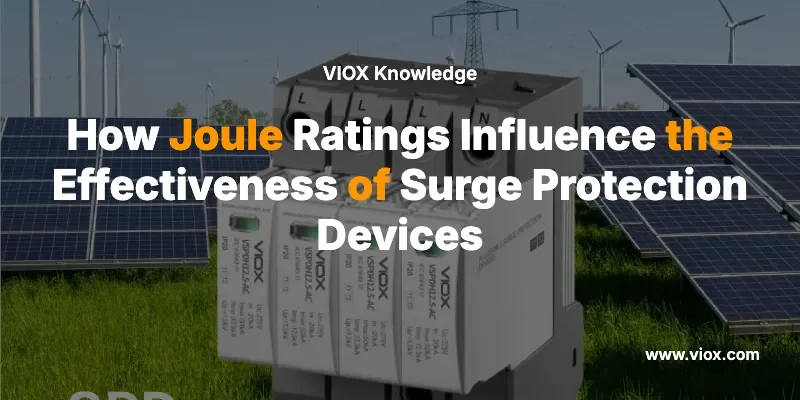Розуміння джоулевих номіналів у контексті захисту від перенапруги
A Джоулевий показник вказує на кумулятивну здатність поглинання енергії пристрою захисту від перенапруги, перш ніж він вийде з ладу або значно погіршить свою роботу. Вимірюваний у джоулях (ват-секундах), цей показник теоретично відображає, скільки енергії перенапруги пристрій може поглинути протягом усього терміну служби. Однак, цей, здавалося б, простий показник приховує кілька критичних обмежень, які впливають на його корисність для визначення СДПГ ефективність.

Здатність поглинати енергію залежить, перш за все, від Металооксидні варистори (MOV) всередині SPD, які є ключовими компонентами, відповідальними за обмеження перенапруг. Номінальний струм Джоуля визначається кількістю, розміром та якістю цих MOV, що працюють у паралельних конфігураціях.
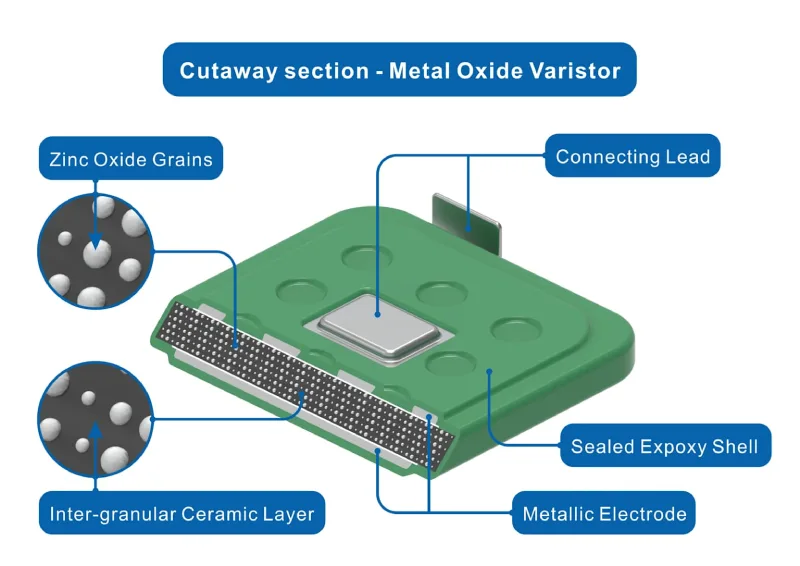
Фундаментальне обмеження: рейтинги Джоуля проти якості захисту
Позиція галузі щодо рейтингів Джоуля
Великі виробники та галузеві організації зі стандартизації однозначно відкидають показники Джоуля як надійні показники ефективності SPDSchneider Electric, провідний виробник SPD, однозначно заявляє, що «номінали Джоуля не є визнаним або надійним показником для визначення ефективності чи продуктивності пристрою захисту від перенапруги». Аналогічно, Інститут захисту від перенапруги NEMA визнає, що «більш авторитетні виробники більше не надають рейтинги енергоспоживання» через їх оманливий характер.
У стандарті IEEE C62.62 чітко зазначено, що специфікації часу відгуку, які часто змішуються з показниками енергоспоживання, «не повинні використовуватися як специфікація» для SPD. Цей галузевий консенсус відображає багаторічний досвід, який демонструє, що показники Джоуля не можуть передбачити фактичну ефективність захисту.
Оманлива природа рейтингів енергоспоживання
Показники Джоуля можуть бути штучно завищені за допомогою методів тестування, які не відображають реальних умов перенапруги.Не існує стандартизованого методу вимірювання енергетичних показників SPD, що дозволяє виробникам використовувати тривалі імпульси або сприятливі умови випробувань для отримання вражаючих, але беззмістовних чисел. Відомо, що деякі виробники використовують «імпульси з довгим хвостом для отримання більших результатів, вводячи кінцевих користувачів в оману».
Специфікації SPD проти аналізу ефективності
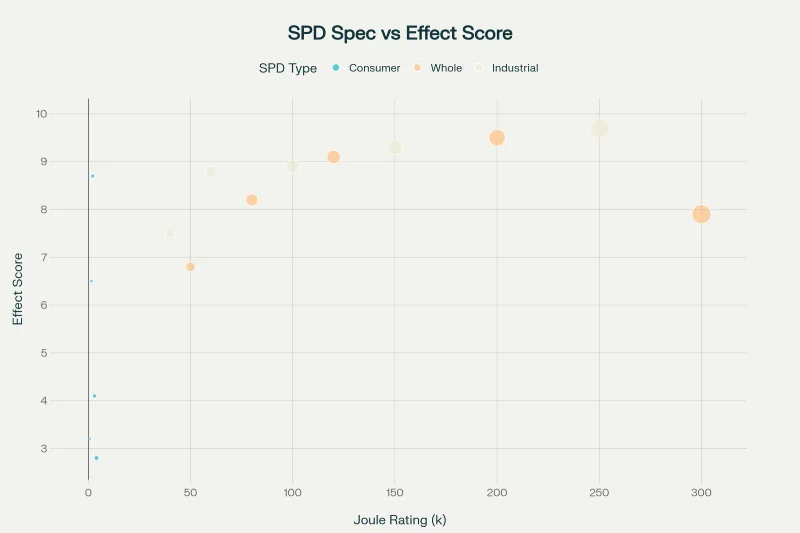
Аналіз показує, що Вищі показники Джоуля не завжди корелюють з кращою ефективністю захисту.Споживчі пристрої захисту від перенапруги з номіналом 800-4000 джоулів демонструють різні показники ефективності, які не відповідають їхнім енергетичним рейтингам, тоді як професійні пристрої захисту від перенапруги зосереджені на зовсім інших характеристиках.
Основні фактори, що визначають ефективність SPD
Затискна напруга (номінальний ступінь захисту від напруги)
Найважливішим фактором ефективності SPD є напруга затискання, яка зараз стандартизована як коефіцієнт захисту від напруги (VPR).Ця специфікація, виміряна за допомогою випробувань UL 1449 з комбінованою хвилею 6 кВ, 3 кА, безпосередньо визначає рівень напруги, який досягає захищеного обладнання під час перенапруги.
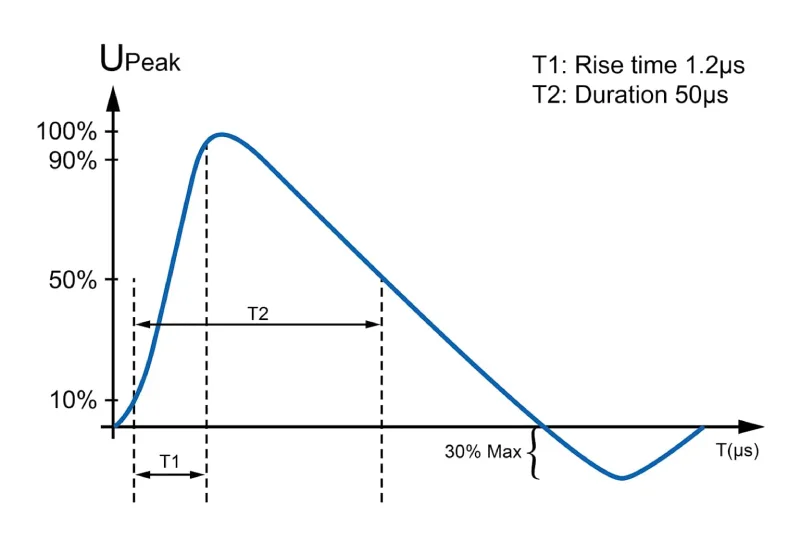
Номінальні значення VPR стандартизовані для певних рівнів (330 В, 400 В, 500 В, 600 В, 700 В, 800 В, 1000 В, 1200 В, 1500 В, 2000 В), що забезпечує узгоджену основу для порівняння характеристик SPD. Нижчі значення VPR забезпечують кращий захист оскільки вони обмежують перенапругу, що досягає чутливого обладнання, до безпечніших рівнів.
Зв'язок між VPR та захистом обладнання базується на кривій допуску напруги Ради інформаційних технологій (ITIC), яка вказує на те, що електронне обладнання зазвичай може витримувати напругу до 5001 TP3T номінальної напруги протягом дуже коротких проміжків часу. Тому SPD з номінальними показниками VPR значно нижчими за цей поріг забезпечують найефективніший захист.
Номінальний струм перенапруги (кА)
Номінальний імпульсний струм, виміряний у кілоамперах (кА), вказує на максимальний імпульсний струм, який SPD може безпечно витримувати.Цей рейтинг, підтверджений випробуваннями UL 1449, безпосередньо пов'язаний зі здатністю SPD витримувати значні перенапруги без збоїв.
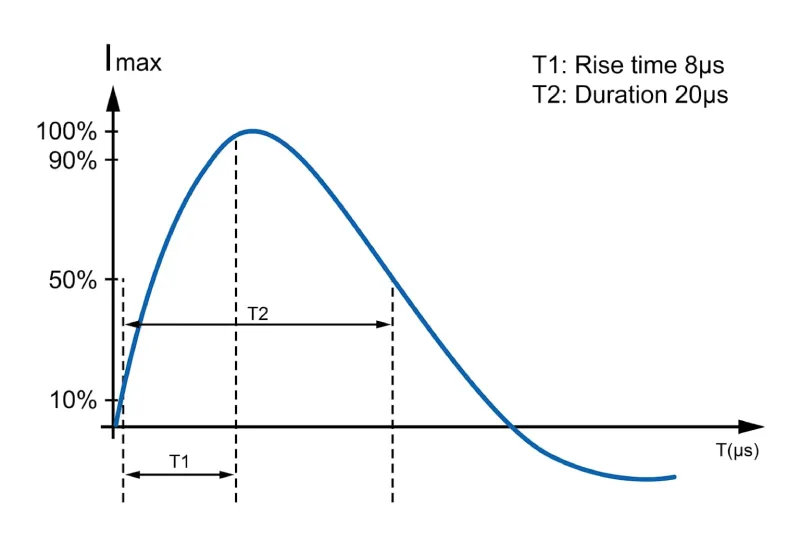 Форма хвилі перенапруги струму, що показує час наростання та тривалість, що стосуються продуктивності SPD та врахування номіналу Джоуля
Форма хвилі перенапруги струму, що показує час наростання та тривалість, що стосуються продуктивності SPD та врахування номіналу Джоуля
Професійні пристрої захисту від перенапруг зазвичай пропонують номінальні струми захисту від імпульсних перенапруг від 50 кА до 200 кА або вище, тоді як споживчі пристрої можуть мати номінальний струм від 4 кА до 15 кА. Вищі номінали kA забезпечують кращий захист від сильних перенапруг та подовжують термін служби SPD шляхом запобігання передчасному виходу з ладу під час значних перенапруг, викликаних блискавкою.
Номінальний струм перенапруги також пов'язаний зі здатністю SPD координувати роботу з іншими захисними пристроями в каскадній схемі захисту, де кілька SPD працюють разом для забезпечення комплексного захисту.
Максимальна тривала робоча напруга (MCOV)
MCOV являє собою найвищу стаціонарну напругу, яку SPD може витримувати, не активуючись та не створюючи загрози безпеці.Ця специфікація є вирішальною для запобігання передчасній деградації SPD через нормальні коливання напруги та тимчасові перенапруги.
Професійні рекомендації рекомендують вибирати SPD з номінальним значенням MCOV щонайменше 115% від номінальної напруги системи, щоб забезпечити надійну роботу за нормальних умов. SPD з недостатнім значенням MCOV можуть неодноразово спрацьовувати під час нормальних коливань напруги, що призводить до передчасного зносу та потенційних загроз безпеці.
Галузеві стандарти та методології тестування
Стандартні вимоги UL 1449
UL 1449, остаточний стандарт безпеки та експлуатаційних характеристик для SPD, повністю зосереджений на VPR, номінальних значеннях імпульсного струму та MCOV, а не на джоулевських значеннях.Методологія тестування стандарту піддає SPD ретельній оцінці, включаючи:
- Випробування захисту від напруги (VPR)Використання комбінованих хвиль 6 кВ, 3 кА для визначення пропусканої напруги
- Випробування номінального струму розрядуЗастосування 15 імпульсів напруги при номінальних рівнях струму для перевірки продовження функціональності
- Тимчасове випробування на перенапругуЗабезпечення безпечної роботи в умовах тривалого перенапруги
Акцент стандарту на цих параметрах відображає їхній прямий зв'язок з ефективністю захисту, тоді як відсутність вимог щодо показника Джоуля підкреслює їх обмежену релевантність для фактичної продуктивності.
Тестове середовище IEEE C62.41
Стандарт IEEE C62.41 визначає середовище з перенапругою та рекомендовані форми випробувальних хвиль для оцінки продуктивності SPD.Цей стандарт встановлює три категорії розташування (A, B, C) залежно від близькості до входу для обслуговування, з відповідними рівнями впливу перенапруг та відповідними формами випробувальних хвиль.
Рекомендовані стандартом форми хвиль (комбінована хвиля, кільцева хвиля та інші) розроблені для імітації реальних умов перенапруги, а не для оптимізації вимірювань поглинання енергії. Такий підхід підкреслює важливість ефективності захисту над кумулятивною здатністю до обробки енергії.
Критерії вибору професійного SPD
Застосування для всього будинку та промисловості
Професійні установки SPD надають перевагу номіналам імпульсного струму та специфікаціям VPR над номіналами Джоуля.. Службові вхідні SPD зазвичай мають:
- Номінальні значення імпульсного струмувід 50 кА до 200 кА або вище
- Рейтинги VPRвід 330 В до 600 В залежно від напруги системи
- Рейтинги MCOVПравильно підібрано до напруги системи з достатнім запасом
- Сертифікація UL 1449 типу 1 або типу 2Забезпечення дотримання стандартів безпеки
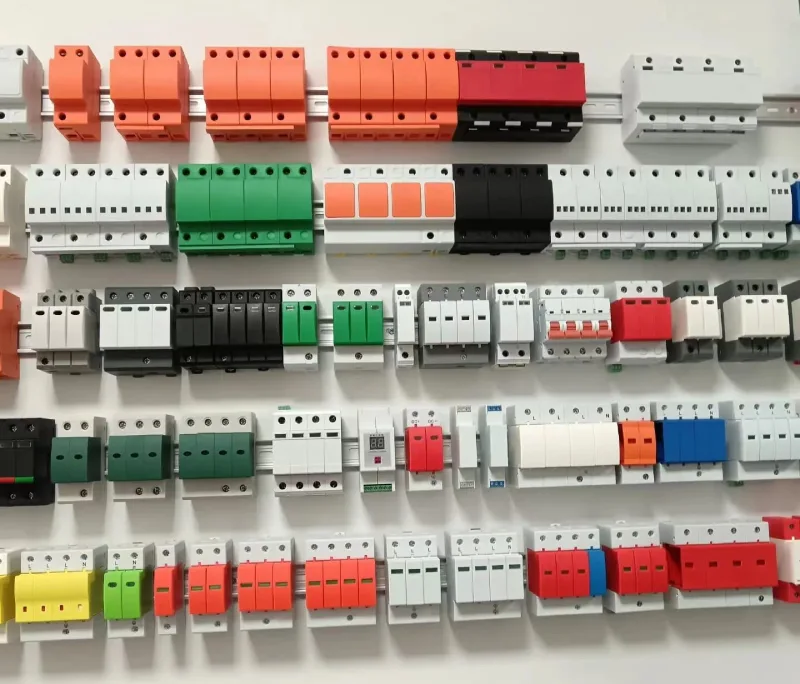
Зосередження уваги на цих параметрах відображає їхній прямий вплив на ефективність захисту та безпеку системи, тоді як показники Джоуля вважаються вторинними показниками довговічності пристрою, а не якості захисту.
Каскадні системи захисту
У професійних установках використовуються каскадні схеми захисту, де кілька пристроїв захисту від перенапруги працюють разом для забезпечення комплексного захисту від перенапруги.У цих системах:
- Службові вхідні SPDВитримує найбільші імпульсні струми завдяки високим номінальним кА
- Панельні SPD-пристроїЗабезпечує вторинний захист із помірними номінальними значеннями кА
- SPD у місцях використанняЗабезпечують остаточний захист з нижчими показниками kA, але з чудовою продуктивністю VPR
Такий підхід визнає, що ефективний захист від перенапруги залежить від скоординованого обмеження напруги, а не від кумулятивного поглинання енергії, що ще більше зменшує актуальність джоулевих показників у професійних застосуваннях.
Роль джоулевих коефіцієнтів у терміні служби SPD
Поглинання енергії та деградація пристрою
Хоча показники Джоуля не визначають ефективність захисту, вони впливають на термін служби SPDВищі показники Джоуля зазвичай вказують на більшу кумулятивну здатність поглинати енергію, що може подовжити термін служби пристрою за умови повторного впливу перенапруги.
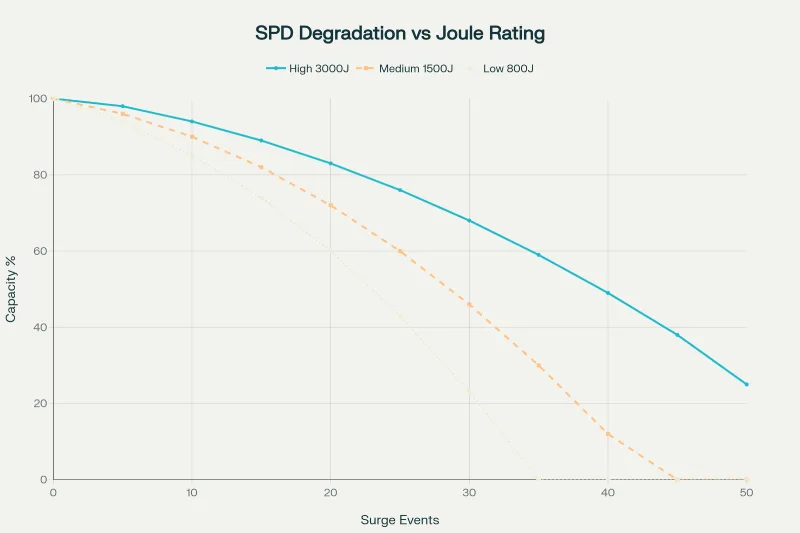
Аналіз деградації показує, що SPD з вищими показниками Джоуля зберігають працездатність довше за умови повторних перенапруг, але всі вони забезпечують еквівалентну якість захисту під час роботи. Цей зв'язок пояснює, чому показники Джоуля залишаються актуальними для планування заміни та технічного обслуговування, навіть якщо вони не впливають на ефективність захисту.
Механізми деградації MOV
Деградація SPD відбувається через кумулятивне пошкодження MOV від повторюваних перенапругКожна подія перенапруги призводить до поступового пошкодження меж зерен оксиду цинку в межах вологозахисних елементів (MOV), поступово знижуючи їхню ефективність. Вищі показники джоуля зазвичай вказують на більші або більш численні MOV, що забезпечує більшу резервну ємність до того, як відбудеться значна деградація.
Однак цей процес деградації впливає на термін служби пристрою, а не на ефективність захисту, оскільки всі SPD забезпечують еквівалентне обмеження напруги за умови правильного вибору розміру та функціонування в межах своїх номінальних характеристик.
Поширені помилки та маркетингові практики
Плутанина на споживчому ринку
Ринок споживчих мережевих фільтрів сильно підкреслює рейтинги Джоуля, незважаючи на їх обмежене значення для ефективності захисту.Такий маркетинговий підхід створює кілька помилкових уявлень:
- Вищі показники Джоуля означають кращий захистХибно – ефективність захисту залежить від VPR та характеристик реагування
- Джоулеві показники вказують на здатність витримувати перенапругиВводить в оману – номінали імпульсного струму (кА) визначають фактичну здатність витримувати імпульсні перенапруги
- Поглинання енергії дорівнює якості захисту: Неправильно – обмеження напруги визначає ефективність захисту
Професійні та споживчі характеристики
Професійні SPD зазвичай применшують або взагалі не надають значення джоуля, зосереджуючись на технічних характеристиках.Такий підхід відображає розуміння галуззю того, що:
- VPR безпосередньо визначає ефективність захисту
- Номінальні значення імпульсного струму вказують на надійність пристрою
- MCOV забезпечує безпечну безперервну роботу
- Джоулеві показники в першу чергу впливають на інтервали заміни
Контраст між професійними та споживчими характеристиками підкреслює розрив між маркетинговими рейтингами енергоспоживання та фактичною ефективністю захисту.
Технічний аналіз та кореляція продуктивності
Слабка кореляція між рейтингами Джоуля та ефективністю
Комплексний аналіз виявляє мінімальну кореляцію між показниками Джоуля та фактичною ефективністю SPD.
Дані показують, що:
- Споживчі SPDПоказники ефективності суттєво відрізняються, незважаючи на схожі показники Джоуля
- Професійні SPDВища ефективність корелює з нижчим VPR та вищими показниками kA, а не з показниками Джоуля.
- Промислові SPDЧудова продуктивність відображає передову технологію MOV та конструкцію схеми, а не енергоємність.
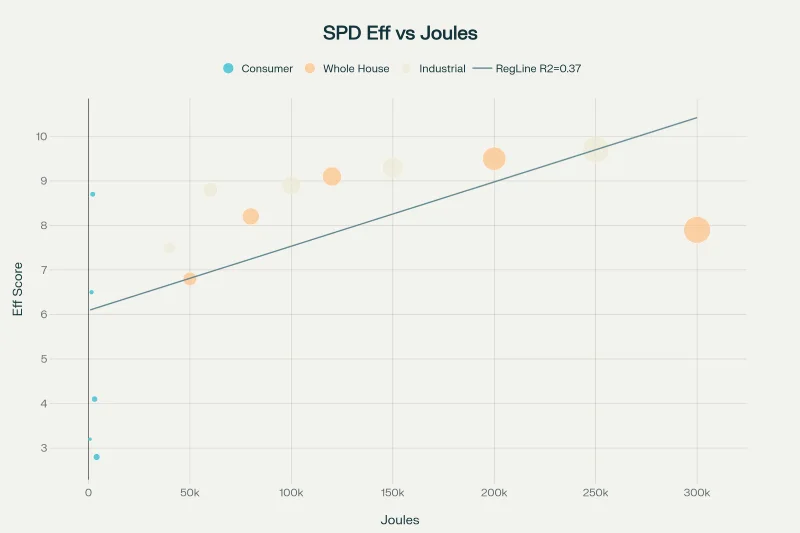 СДПГ Аналіз ефективності: демонстрація слабкої кореляції між показниками джоуля та фактичною ефективністю SPD, з анотаціями, що пояснюють, чому інші фактори є більш важливими.
СДПГ Аналіз ефективності: демонстрація слабкої кореляції між показниками джоуля та фактичною ефективністю SPD, з анотаціями, що пояснюють, чому інші фактори є більш важливими.
Цей аналіз підтверджує, що показники Джоуля є поганими предикторами ефективності захисту, тоді як показники VPR та імпульсного струму демонструють сильну кореляцію з фактичною продуктивністю.
Багатофакторний аналіз ефективності
Ефективний вибір SPD вимагає врахування кількох взаємопов'язаних факторів, а не покладатися на окремі специфікації.
Комплексна система оцінювання включає:
- Первинні факториVPR, номінальний струм перенапруги, MCOV
- Вторинні факториЧас відгуку, коефіцієнт Джоуля, фізична конструкція
- Фактори безпекиВідповідність стандарту UL 1449, захист від виходу з ладу, вимоги до встановлення
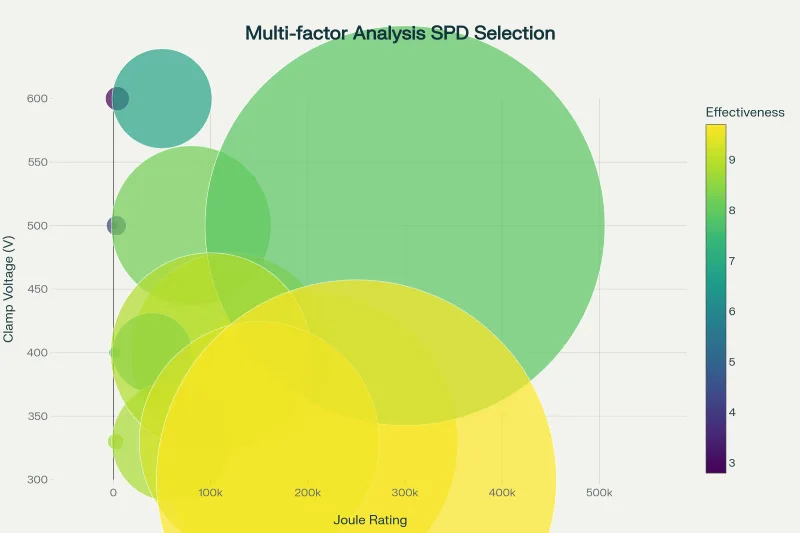
Такий багатофакторний підхід забезпечує оптимальну ефективність захисту, уникаючи обмежень вибору одного параметра на основі показників Джоуля.
Рекомендації щодо вибору SPD
Керівні принципи професійного відбору
Правильний вибір SPD повинен пріоритезувати перевірені показники ефективності над маркетинговими специфікаціями:
- Першочергове врахуванняВиберіть SPD з рейтингами VPR, що відповідають вразливості захищеного обладнання.
- Пікова ємністьВиберіть номінали струму перенапруги залежно від місця встановлення та рівня впливу
- Робочі параметриПереконайтеся, що номінальні значення MCOV забезпечують достатній запас вище напруги системи
- Відповідність стандартамПеревірте сертифікацію UL 1449 для підтвердження безпеки та продуктивності
- Другорядний розглядВраховуйте джоулеві показники для планування технічного обслуговування та заміни
Рекомендації щодо конкретного застосування
Різні застосування вимагають індивідуальних підходів до вибору SPD:
- Житлові застосуванняЗосередьтеся на VPR ≤ 400 В та номінальних струмах перенапруги ≥ 40 кА для входу обслуговування
- Комерційні установкиНадавати пріоритет VPR ≤ 330 В та номіналам імпульсного струму ≥ 80 кА для основних панелей.
- Промислові об'єктиЗосередьтеся на VPR ≤ 300 В та номінальних значеннях імпульсного струму ≥ 100 кА для захисту критично важливого обладнання.
- Центри обробки данихПотрібна напруга VPR ≤ 330 В з швидким часом відгуку та високими номінальними значеннями імпульсного струму
Висновок
Джоулеві показники мають мінімальний вплив на ефективність SPD, слугуючи переважно показниками довговічності пристрою, а не якості захисту.Розширений аналіз показує, що хоча показники Джоуля відображають кумулятивну здатність поглинати енергію, вони не визначають здатність SPD захищати підключене обладнання від пошкоджень від перенапруги.
Найважливішими факторами, що впливають на ефективність SPD, є напруга блокування (VPR), номінальний імпульсний струм та максимальна тривала робоча напруга (MCOV).Ці параметри, стандартизовані за допомогою випробувань UL 1449, безпосередньо впливають на ефективність та безпеку захисту. Професійні виробники SPD та галузеві організації зі стандартизації послідовно надають пріоритет цим характеристикам над характеристиками Джоуля під час оцінки ефективності захисту.
Для оптимального захисту від перенапруги рішення щодо вибору повинні ґрунтуватися на перевірених показниках ефективності, підтверджених визнаними стандартами випробувань.Хоча показники Джоуля можуть враховуватися при складанні графіків технічного обслуговування та плануванні заміни, вони не повинні бути основним фактором у визначенні ефективності захисту від перенапруги. Розуміння цієї різниці має вирішальне значення для впровадження ефективних стратегій захисту від перенапруги, які дійсно захищають чутливе електронне обладнання від пошкоджень, пов'язаних з перенапругою.
Докази чітко свідчать про те, що Ефективний захист від перенапруги залежить від здатності фіксувати напругу та здатності витримувати перенапругу, а не від сумарного поглинання енергії.Це розуміння має керувати всіма рішеннями щодо вибору SPD, гарантуючи, що ефективність захисту має пріоритет над маркетинговими специфікаціями, які можуть не відображати фактичні можливості експлуатації.
Пов'язане
Як SPD відводять або обмежують перехідні напруги для забезпечення безпеки та надійності
Чим пристрої захисту від перенапруги (SPD) відрізняються від інших методів захисту від перенапруги
Що таке пристрій захисту від перенапруги (SPD)
Пристрої захисту від перенапруги: переваги та недоліки

